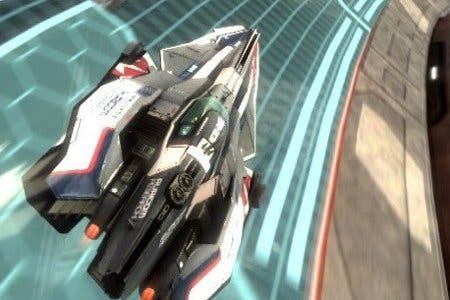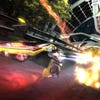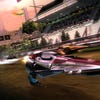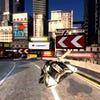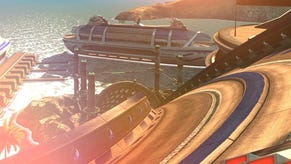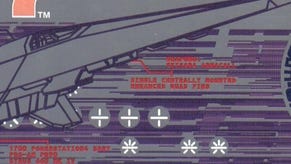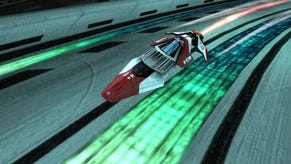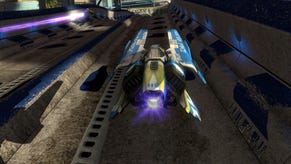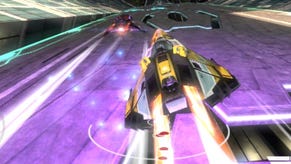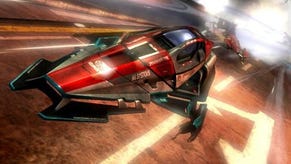WipEout 2048 Review
Weightless wonder.
I've found a new way to terrify myself. It's not by counting the grey hairs in my beard, nor is it by examining my receding hairline, checking my bank balance or reading up on whatever tropical disease is in vogue. It's by surrendering myself to WipEout 2048, and more specifically, to Zone mode on the track Sol.
It's the drop halfway around this sky-bound track that does the trick; a blind crest that gives way to nothing, the track pulled from beneath you and leaving you suspended for a handful of panicked seconds. It's made more urgent by Zone's airbrushed psychedelics, and more urgent still by the steadily escalating speed of the ship at your fingertips.
This is WipEout at its best, and it's preserved, in part, for the series' Vita debut. WipEout's been much more than a futuristic racing series since its inception - it's been one that's screamed that the future is, in fact, now. It started with the PlayStation debut, a game that did more than just usher in the 3D age - it lent gaming an edgy credibility that helped pave the path to success for Sony's then fledgling interactive empire.
More recently, WipEout HD was proof of concept for a future that's yet to be fully realised. Here was gaming in 1080p and at 60fps, all served up as a digital download. It's a technical feat that's sadly been replicated rarely since, ensuring that both HD and Fury remain high watermarks in the PS3's library.
And now there's WipEout 2048, providing proof of the Vita's abilities as a high-end, high-spec portable. It's an effective showcase, too - witnessing the fidelity and detail as seven fellow anti-grav racers make a violent ascent from a busy New York cityscape, all between the palms of your hands, has as much impact now as the original did some 17 years ago.
Studio Liverpool has turned the clock back to attain that spectacle, offering up a prequel of sorts. A stirring intro video traces the line from Brooklands race track to a near-future Brooklyn, telling how the world of racing lifted itself above the tarmac. There's another line being drawn here - the vehicles of WipEout 2048 are, with more primitive lines and an audible chug and whine, anti-gravity racing's Napiers.
And so the concrete and steel of previous WipEouts is swapped out for the stonework and masonry of a half-imagined, half-real take on New York. Races zip across the Brooklyn Bridge, scale the side of the Empire State Building and spiral through shopping malls. There's a story being told here, too - throughout the three seasons of 2048's single player campaign, WipEout's more traditional vision slowly emerges, culminating in visits to Altima and Sol, tracks from the series' past.
It's WipEout's most dramatic aesthetic shift, but it's not necessarily its most successful. Without the cleanliness and clarity of the future of old, there's a visual clutter that shifts the emphasis away from skill and more towards luck. Find yourself at the back of the pack and the track ahead is a mess of vapour trails and plasma showers, obscuring a route that's already in danger of getting lost amidst the brickwork.
It's impressive how much Studio Liverpool can throw on the screen, but often it comes at the expense of WipEout's purity of design, as well as some of its practicality. Load times before races come in between 30 and 40 seconds, an unacceptable wait in the more immediate world of portable gaming.
A little clarity's been lost in the handling, too. It's arguable that Sony Liverpool's a victim of its own success here. Having delivered a weighty and satisfying model strung out across 60fps in both HD and Fury, and having delivered in 2048 a game that comes shockingly close to its PS3 counterparts visually, the dip in frame-rate and the move to the Vita's less substantial analogue stick stings a little. There's no doubt that some of the weight has been lost as well, and while 2048's tracks have been widened to accommodate for the loss of handling fidelity, frequent collisions with the scenery sap away some of the grace.
It's a credit to WipEout's well-worn formula that, despite these problems, 2048 remains an enjoyable and often exhilarating ride. The career, structured as it is across three seasons and underscored by the gentle tug of XP, provides a satisfying departure from the latticed event grids of Pure, Pulse, HD and Fury.
Events are weighted towards traditional races, working their way up through a refined class system where series staples such as phantom, venom and rapier are replaced with a simple grading system running from C through to A plus - where survival is all about pre-empting the next 500 yards.
And races, cluttered as they are, tend towards a chaos that's served by a tweaked weapons system. Each team's garage - and 2048 takes in all the classics, from Feisar through to Pir-hana - is split into four categories, from the self-explanatory agility, speed and fighter classes to the unruly prototypes that are the last to be unlocked. They each offer separate load-outs, with certain weapons excluded from certain teams, while weapon pads now come in both defensive and offensive flavours.
It sprinkles strategy on the combat, though it's still far from thoughtful. Combat events, where the aim is to destroy rather than race, are exercises in pure aggression where the odds can be stacked in your favour with some canny ship selection. Online combat events descend further into chaos, often sinking into farce as competitors are free to tear around the track any which way in order to rack up the highest score.
It's one moot point in online racing that's well structured, smart and - over a wi-fi connection, at least - simple to use. Each race presents a new objective - hit a certain rival for a gold star, for example, or finish in the front half of the field - and as each is ticked off, progress is made in a linear seasonal series. Coming first is not necessarily the primary aim, a concept that may well be anathema to racers - and working towards a well-deserved victory only to be told you've failed your objective can prove galling - but in its place is the kind of frenetic action that's defined Mario Kart and has, to date, been lacking a little from WipEout.
But 2048's at its best when it's applying itself to more traditional WipEout endeavours, and that's when Studio Liverpool's work really shines. That's where its winning details reveal themselves: the cruel placement of speed pads on a corner's apex that can either send you hurtling towards a wall or propel you to victory, for example, or how the rhythm of each circuit is amplified through a string of perfect laps.
WipEout is several steps down from the series' best, but is still a robust and muscular racer, and one that with its solid online and dazzling visuals, does much to recommend its host hardware - doing enough to suggest that the Vita's own future is bright.
This is a review of the Japanese import version of WipEout Vita, which at present doesn't allow access to cross-platform play. We'll be investigating that feature in full around the game's release in Europe on February 22.
